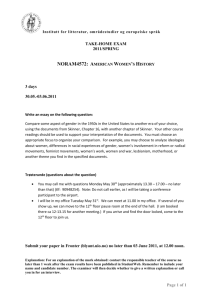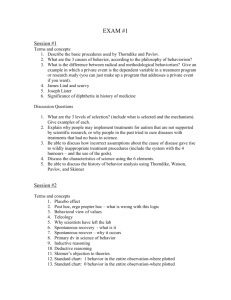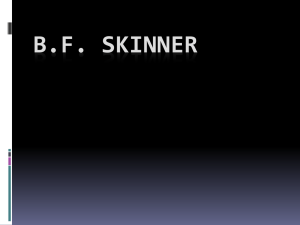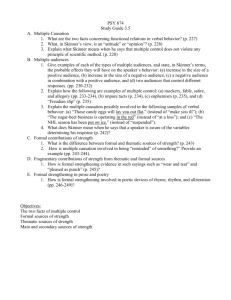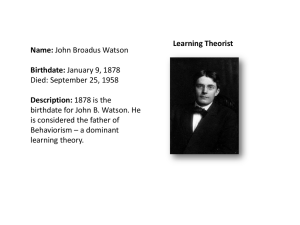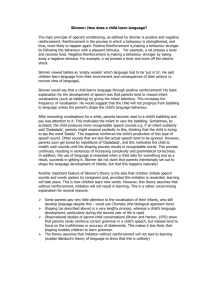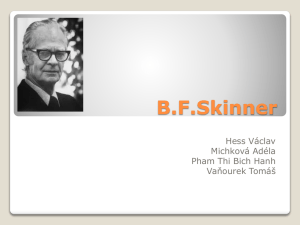bf skinner: behaviorism 2
advertisement
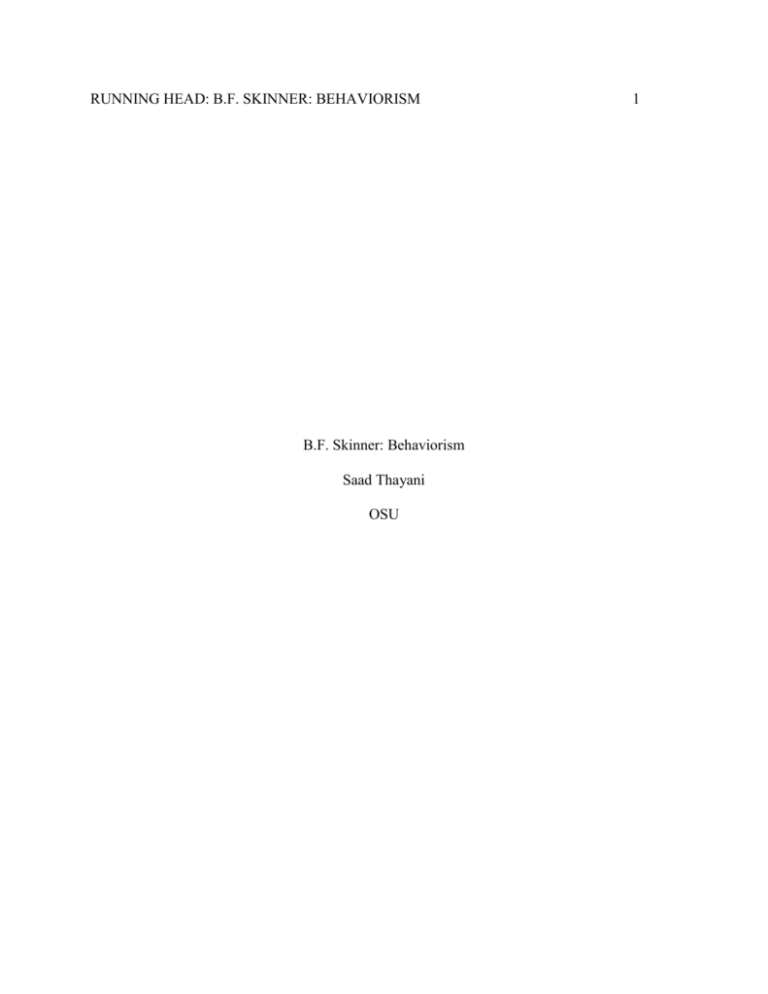
RUNNING HEAD: B.F. SKINNER: BEHAVIORISM B.F. Skinner: Behaviorism Saad Thayani OSU 1 B.F. SKINNER: BEHAVIORISM 2 Introduction “Burrhus Frederic Skinner was born March 20, 1904, in the small Pennsylvania town of Susquehanna”(Boeree, 2006). His father, William was a lawyer and his mother, Grace did not have work so she stayed home and was a housewife. Skinner also had a brother named Ebbie; he died from a cerebral hemorrhage at the age of 16. (Moloney, 2009) Skinner wanted to be a writer originally. “Leaving home for New York City, he worked as a bookstore clerk where he discovered behavioral science in Pavlov’s Conditioned Reflexes and Watson’s Behaviorism. Inspired by these books, Fred Skinner decided to exchange literature for of psychology; he enrolled in the Psychology Department of Harvard University in 1928.” (Boeree, 2006) While Skinner was in college he studied behaviorism, which is the actions of human beings or animal, not factoring in the feeling or thoughts. “Skinner completed his PhD studies in psychology at Harvard.”(Schacter, Gilbert, Wegner, 2011, p. 17) According to (Boeree, 2006). In 1936, B.F. Skinner moved to University of Minnesota to teach. There he also met Yvonne Blue, they got married and had two daughters. His second daughter was “famous” for being the first to be raised in the air crib, which Skinner had invented. The air crib was basically a crib with glass walls to air condition the baby (Boeree, 2006). “August 18, 1990, B. F. Skinner died of leukemia after becoming perhaps the most celebrated psychologist since Sigmund Freud.” (Boeree, 2006) Skinner Box Skinner noticed that animals do something and interact with other objects and animals; they don’t just stand around like a statue. According to their environments animals do many different things such as finding food, shelter, and members of the opposite sex. Skinner B.F. SKINNER: BEHAVIORISM 3 wondered if he could figure out how they learned to act in those types of scenarios. (Schacter, Gilbert, Wegner, 2011, p. 17) After pondering how to do this, he built a “conditioning chamber” but that phrase did not catch on and the rest of the world called it the “Skinner box.” (Schacter, Gilbert, Wegner, 2011, p. 17) “In the Skinner box, a rat was operantly conditioned to press a lever by receiving food pellet reinforcement after number of lever presses.” (Moloney, 2009) So basically what the Skinner Box did was a rodent was put into this “Skinner Box” and inside the box it would have a lever. If the rodent presses this lever it would deliver a food piece. The rodent would walk around the box and would accidently press the lever again and again, until it wasn’t hungry anymore. Whenever the rodent was hungry, it would start walking around until the lever was activated again. This is when Skinner introduced the principle of reinforcement. Reinforcement “Reinforcement, which states that the consequences of a behavior determine whether it will be more or less likely to occur again.” (Schacter, Gilbert, Wegner, 2011, p. 17) Another form of reinforcement is continuous reinforcement, which is each time the rodent does the same thing; such as pushing the lever it receives another food piece. Behavior What is behavior? Behavior is the term used to describe the actions of human beings and non-human animals. Skinner solely studied behaviorism, which lead to his study of operant behavior. “Operant behavior: to refer to behavior that an organism produces that has some impact on the environment. (Schacter, Gilbert, Wegner, 2011, p. 278) There are three different types of operant behaviors which are neutral operants, reinforce, and punisher. B.F. SKINNER: BEHAVIORISM 4 According to (McLeod, 2007) a neutral operant is a response from the environments that neither increase nor decrease the probability of a behavior being repeated. “Reinforcers: Responses from the environment that increase the probability of a behavior being repeated. Reinforcers can be either positive or negative.” (McLeod, 2007) A positive reinforcement would be if you clean your room, your parents award you to go out with your friends. This concept influences the child’s behavior. “The removal of an unpleasant reinforcer can also strengthen behavior. This is called Negative Reinforcement because it is the removal of an adverse stimulus which is ‘rewarding’ to the animal.” (McLeod, 2007) The example here would be if you don’t clean your room, you take your parents out. Punishment is the exact opposite of reinforcement, because instead of increasing the behavior, it completely gets rid of it. (McLeod, 2007) Our behaviors are small pieces fit together likes to create a big puzzle. Otherwise known as shaping. Shaping: learning that results from the reinforcement of successive stems to a final desired behavior. (Schacter, Gilbert, Wegner, 2011, p. 284) An example of shaping would be teaching a kid to dribble a ball, and then teach the kid to shoot a basketball. Then put it all together in the game of basketball. The small pieces of dribbling and shooting are put together to form one picture. The players in the National Basketball Association all learned the same way, now they perform smoothly but it wasn’t like that before they learned to play. Reflection B.F. Skinner was an extraordinary person; his concepts of reinforcement and behaviorism were interesting and drew me in to research him. I personally enjoyed researching him and his theory’s. I had honestly thought psychology would not be the subject I would be interested in, B.F. SKINNER: BEHAVIORISM 5 until this person. I learned so much about behavior that I would of never have known before. I also learned about operant behavior, which I see my own parents use on me. Punishment and reinforcement to stop and influence my behavior as a child, which has made me how I am thanks to how B.F. Skinner studied behaviorism, and only behaviorism. B.F. SKINNER: BEHAVIORISM 6 References Boeree, C. G. (2006). B. F. Skinner. My Webspace files. Retrieved from http://webspace.ship.edu/cgboer/skinner.html McLeod, S. A. (2007). B.F. Skinner | Operant Conditioning. Simply Psychology - Psychology Articles for Students. Moloney, S. (2009). B.F. Skinner. The Pennsylvania Center for the Book. Retrieved from http://pabook.libraries.psu.edu/palitmap/bios/Skinner__BF.html Schacter, D. L., Gilbert, D. T., Wegner, D. M., & Linsmeier, C. (2011). Psychology(2nd ed.). New York: Worth publishers.

